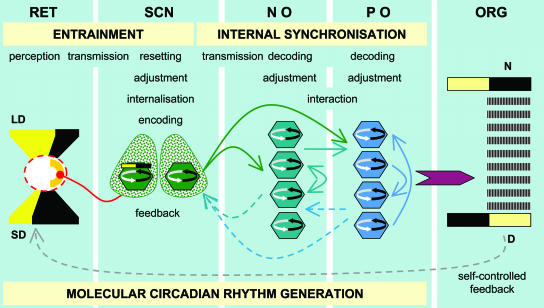Fig. 1.
Mammalian circadian organization at the whole-organism level. Entrainment begins with the perception of light in the retina [RET; light input, shown as either long day (LD) or short day (SD)] and the transmission of photic information, reflecting the ratio of light and dark, to the SCN. Resetting of the clock, adjustment of biological time, internalization of environmental time, and encoding into particular output signals take place in the SCN. Internal synchronization is accomplished by spreading time-coded information to self-sustained neural oscillators (NO) and peripheral oscillators (PO). Biological time in NO and PO is adjusted, and a cascade of interaction and feedback mechanisms in NO and PO, as well as between NO and PO, and feedback signals toward the SCN result in coordinated rhythmicity of general physiology and behavior at the whole-organism level (ORG) that reflects the environmental light–dark cycle and may species-specifically be adjusted to the light (diurnal, D) or dark (nocturnal, N) phase. Molecular circadian rhythms are generated at all levels of organization. “Self-controlled feedback,” i.e., the determination of light input to the system by the activity of the animal, closes the loop, and the circadian cycle starts again.

